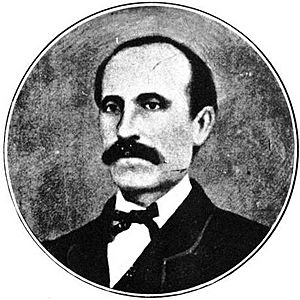Josep Maria Ventura i Casas facts for kids
Josep Maria Ventura i Casas (born in Alcalá la Real, Jaén, in 1817 – died in Figueres, Catalonia, in 1875), known as Pep Ventura, was a famous Spanish musician and composer. He came from Catalonia and is celebrated for making big changes to the traditional sardana dance and the cobla orchestra. Many people call him the "father of the modern Sardana" because he made these musical pieces longer and added new instruments to the cobla. His work helped shape Catalan music, and he became a very important cultural figure.
Contents
Pep Ventura's Early Life
Pep Ventura's family originally came from the Empordà region in Catalonia. He was born in Andalusia, a different part of Spain. His father was a military officer who was working there after the War of Spanish Independence. When Pep was two years old, his family moved back to Catalonia, settling in Roses in 1819.
Sadly, Pep Ventura soon became an orphan and went to live with his grandfather. He learned how to be a tailor. He also started learning music, specifically solfège (music reading), from his future father-in-law, Joan Llandrich. Joan Llandrich was the leader of a local music group called a cobla. Around 1848, Pep Ventura took over leading the Llandrich cobla.
Changing the Sardana Dance
Pep Ventura felt that the traditional sardana dance was too short. It usually had only 98 musical measures and lasted just about two minutes. He wanted to make the sardana longer and more interesting.
He became a key person in changing the sardana. He started creating "long sardanes," which had an unlimited number of measures. This was a big change from the older, shorter versions of the dance.
Reforming the Cobla Orchestra
Ventura also thought the traditional cobla orchestra was too small. The old "cobla de tres quartans" usually had only a few instruments like bagpipes, a shawm, a flabiol (a small flute), and a tambori (a small drum).
He began to transform the cobla. At first, he made it bigger, with five or seven musicians. Over time, he added more brass instruments. He also organized the woodwind and brass instruments into two rows, with a double bass at the front. Other coblas soon copied his new model. This new setup is still used by coblas today, with only small changes. One important instrument he added was the tenora, which was created by Andreu Turon around 1849.
His new musical ideas and the changes he made to the cobla helped him become very famous. He even performed for Queen Isabella II of Spain at the Monastery of Montserrat. This performance, along with other artists from the Renaixença (a cultural movement), made him a celebrated figure in Catalan culture.
His Lasting Musical Legacy
Pep Ventura passed away in 1875 in Figueres. He left a huge mark on Catalan music. Many of his melodies were later arranged by other famous musicians like Pujol, Nicolau, and Lluís Albert. These arrangements helped keep his music alive.
He composed 312 long sardanes, many of which didn't have specific titles. He also wrote many short sardanes and pieces for choirs. In total, he created about 550 musical works. His original handwritten music is kept safe in the archives of the Orfeó Català, a famous Catalan choir.
See also
 In Spanish: José Ventura para niños
In Spanish: José Ventura para niños


